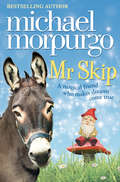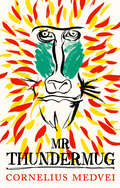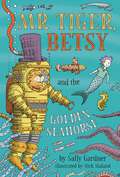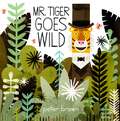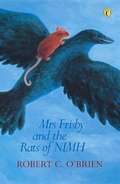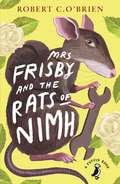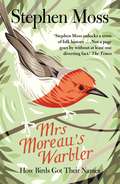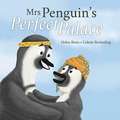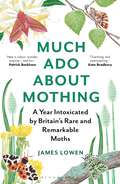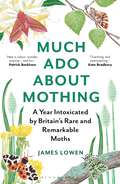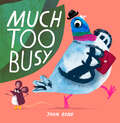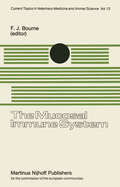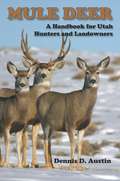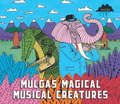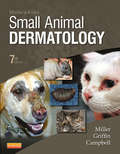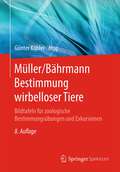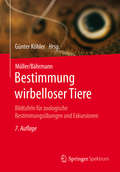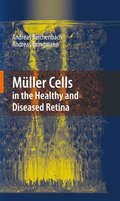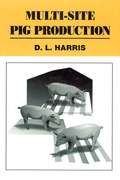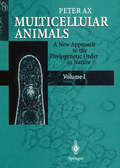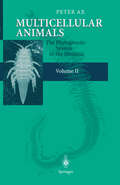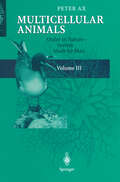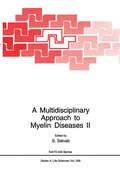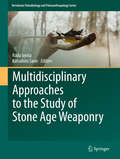- Table View
- List View
Mr Thundermug: A Novel
by Cornelius MedveiThe charming, funny and whimsical tale of Mr Thundermug, the baboon who miraculously speaks a very proper English. Along with a collection of lithographs, this outlandish tale will take readers by surprise.
Mr Tiger, Betsy and the Golden Seahorse
by Sally GardnerFollowing the success of their first two adventures Mr Tiger, Betsy and the Blue Moon and Mr Tiger, Betsy and the Sea Dragon, the intrepid pair join Betsy's mum, Myrtle the mermaid, beneath the waves, from bestselling author Sally Gardner and illustrated by Nick Maland. Crumble cakes! When Betsy joins Myrtle the mermaid in her underwater world, she discovers there may be monsters . . . shipwrecks, lost treasure and secret cities. A seapig's prize seahorse, Pudding Pie, has been stolen by a cantankerous giant octopus and Betsy and Mr Tiger must go to the rescue in their new submarine. But what happens when a tiger's whiskers and tail are simply too long to squeeze into forgotten dark caverns where even the moon cannot shine, and Betsy has to take the final steps of the adventure on her own?The hardback edition of this book is printed in blue ink in Dyslexie, a font specially designed to make reading easier – and more fun.Praise for Sally Gardner: 'This enchanting series is an absolute delight... Striking just the right note of whimsy and magic' THE BOOKSELLER'An idiosyncratic genius' THE TIMES'Gardner's skill is to contain even her wildest ideas within a meticulous plot' DAILY TELEGRAPH
Mr Tiger Goes Wild
by Peter Brown"Funky, funny and beautiful, this is an irresistible addition to every wild child's bookshelf."– The TimesAre you bored with being sensible? Do you want to have more fun? Mr. Tiger knows exactly how you feel. Fed up with tea parties, top hats and talking about the weather, he astounds his friends when he decides to go... WILD. But does he go too far? After all, the wilderness can get pretty lonely.Mr Tiger Goes Wild is a beautifully illustrated and brilliantly funny book from Caldecott Honor-winning artist Peter Brown that shows that there's a time and place for everything... even going wild. Peter Brown is also the creator of many other books including the fantastically funny My Teacher is a Monster! (No, I Am Not).
MRI/DTI Atlas of the Rat Brain
by Charles Watson George Paxinos Evan Calabrese Alexandra Badea G Allan JohnsonMRI/DTI Atlas of the Rat Brain offers two major enhancements when compared with earlier attempts to make MRI/DTI rat brain atlases. First, the spatial resolution at 25µm is considerably higher than previous data published. Secondly, the comprehensive set of MRI/DTI contrasts provided has enabled the authors to identify more than 80% of structures identified in The Rat Brain in Stereotaxic Coordinates. Ninety-six coronal levels from the olfactory bulb to the pyramidal decussation are depictedDelineations primarily made on the basis of direct observations on the MRI contrastsEach of the 96 open book pages displays four items— top left, the directionally colored fractional anisotropy image derived from DTI (DTI - FAC); top right, the diffusion-weighted image (DWI); bottom left, the gradient recalled echo (GRE); and bottom right, a diagrammatic synthesis of the information derived from these three images plus two additional images, which are not displayed (ARDC and RD). This is repeated for 96 coronal levels, which makes the levels 250 μm apart.The FAC images are shown in full colorThe orientation of sections corresponds to that in Paxinos and Watson’s The Rat Brain in Stereotaxic Coordinates, 7th Edition (2014)The images have been obtained from 3D isotropic population averages (number of rats=5). All abbreviations of structure names are identical to the Paxinos & Watson histologic atlas.
Mrs Frisby and the Rats of NIMH
by Robert C. O'BrienTime is running out for Mrs Frisby. She must move her family of mice before the farmer destroys their home. But her son, Timothy, is too ill to survive the move. Help comes in the unexpected form of a group of mysterious, super-intelligent rats. But the rats are in danger too, and little by little Mrs Frisby discovers their extraordinary past.
Mrs Frisby and the Rats of NIMH (A Puffin Book #40)
by Robert C. O'BrienThey are not like other rats. They work at night, in secret . . .Time is running out for Mrs Frisby. She must move her family of mice before the farmer destroys their home. But her youngest son, Timothy, is too ill to survive the move. Help comes in the unexpected form of a group of mysterious, super-intelligent rats. But the rats are in danger too, and little by little Mrs Frisby discovers their extraordinary past . . .
Mrs Moreau's Warbler: How Birds Got Their Names
by Stephen MossSwallow and starling, puffin and peregrine, blue tit and blackcap. We use these names so often that few of us ever pause to wonder about their origins. What do they mean? Where did they come from? And who created them?The words we use to name birds are some of the most lyrical and evocative in the English language. They also tell incredible stories: of epic expeditions, fierce battles between rival ornithologists, momentous historical events and touching romantic gestures.Through fascinating encounters with birds, and the rich cast of characters who came up with their names, in Mrs Moreau's Warbler Stephen Moss takes us on a remarkable journey through time. From when humans and birds first shared the earth to our fraught present-day coexistence, Moss shows how these names reveal as much about ourselves and our relationship with the natural world as about the creatures they describe.
Mrs Penguin’s Perfect Palace
by Helen BrainThe Penguin family lives on the beach, surrounded by rubbish. Until one day, Mrs Penguin says: we need a house! But how will they build one? Celeste Beckerling (illustrator), Arthur Attwell (designer).
Much Ado About Mothing: A year intoxicated by Britain’s rare and remarkable moths
by James LowenAlthough mostly unseen by us, moths are everywhere. And their capacity to delight astounds.Inspired by a revelatory encounter with a Poplar Hawk-moth – a huge, velvety-winged wonder wrapped in silver – James Lowen embarks on a year-long quest to celebrate the joy of Britain's rarest and most remarkable moths. By hiking upmountains, wading through marshes and roaming by night amid ancient woodlands, James follows the trails of both Victorian collectors and present-day conservationists. Seeking to understand why they and many ordinary folk love what the general public purports to hate, his investigations reveal a heady world of criminality and controversy, derring-do and determination.From Cornwall to the Cairngorms, James explores British landscapes to coax these much-maligned creatures out from the cover of darkness and into the light. Moths are revealed to be attractive, astonishing and approachable; capable of migratory feats and camouflage mastery, moths have much to tell us on the state of the nation's wild and not-so-wild habitats.As a counterweight to his travels, James and his young daughter track the seasons through a kaleidoscope of moth species living innocently yet covertly in their suburban garden. Without even leaving home, they bond over a shared joy in the uncommon beauty of common creatures, for perhaps the greatest virtue of moths, we learn, is their accessibility. Moths may be everywhere, but above all, they are here. Quite unexpectedly, no animals may be better placed to inspire the environmentalists of the future.
Much Ado About Mothing: A year intoxicated by Britain’s rare and remarkable moths
by James LowenAlthough mostly unseen by us, moths are everywhere. And their capacity to delight astounds.Inspired by a revelatory encounter with a Poplar Hawk-moth – a huge, velvety-winged wonder wrapped in silver – James Lowen embarks on a year-long quest to celebrate the joy of Britain's rarest and most remarkable moths. By hiking upmountains, wading through marshes and roaming by night amid ancient woodlands, James follows the trails of both Victorian collectors and present-day conservationists. Seeking to understand why they and many ordinary folk love what the general public purports to hate, his investigations reveal a heady world of criminality and controversy, derring-do and determination.From Cornwall to the Cairngorms, James explores British landscapes to coax these much-maligned creatures out from the cover of darkness and into the light. Moths are revealed to be attractive, astonishing and approachable; capable of migratory feats and camouflage mastery, moths have much to tell us on the state of the nation's wild and not-so-wild habitats.As a counterweight to his travels, James and his young daughter track the seasons through a kaleidoscope of moth species living innocently yet covertly in their suburban garden. Without even leaving home, they bond over a shared joy in the uncommon beauty of common creatures, for perhaps the greatest virtue of moths, we learn, is their accessibility. Moths may be everywhere, but above all, they are here. Quite unexpectedly, no animals may be better placed to inspire the environmentalists of the future.
Much Too Busy
by John BondA brilliant new picture book from major talent John Bond, creator of Mini Rabbit.
The Mucosal Immune System: Proceedings of a Seminar in the EEC Programme of Coordination of Agricultural Research on Protection of the Young Animal against Perinatal Diseases, held at the University of Bristol, School of Veterinary Science, Langford, Nr. Bristol, United Kingdom on September 911, 1980 (Current Topics in Veterinary Medicine #12)
by F. J. BourneThis publication contains the proceedings of a Seminar on 'The Mucosal Immune System' held by the Commission of the European Communities (CEC) at the University of Bristol. School of Veterinary Science. Langford. Bristol on September 9th - 11th. 1960. The seminar formed part of the CEC programme of co-ordinated agricultural research on Protection of the Young Animal against Perinatal Disease and was organised by Professor F.J. Bourne and his colleagues Dr. T.J. Newby and Dr. C.R. Stokes. The Proceedings were edited by the organisers assisted by Janssen Services. 33a High Street. Chislehurst. Kent and provide an authoritative and up-to-date account of this rapidly moving research area. Serious economic loss from diseases of mucosal surfaces - particularly the enteric and respiratory tracts - occurs in young farm animals throughout the EEC. Protection against these diseases is based on an understanding of their epidemiology including host defence mechanisms. Mucosal vaccines have in the main given disappointing field results with. however. some notable exceptions. This seminar rationalises methods used to stimulate mucosal immune defence and indicates likely areas for future research and development. The CEC wishes to thank the organisers and the participants who con tributed to the success of the seminar. OPENING SESSION Chairman F.J. Bourne 3 OPENING REMARKS F.J. Bourne On behalf of the University of Bristol and the European Economic Community my colleagues and I welcome you to the Langford Veterinary School.
Mule Deer: A Handbook for Utah Hunters and Landowners
by Dennis D. AustinA complete guide to the history, biology, hunting, and management of mule deer in Utah. The author, Dennis D. Austin, is a retired research scientist with more than thirty years of experience working as a wildlife biologist for the Utah Division of Wildlife Resources.
Mulga's Magical Musical Creatures
by MulgaGuitar-playing fishes? Gorillas on drums? Fluting kangaroos? Join Mulga in his dreamy jungle jam session, where magical animals play sweet tunes from night till day.Mulga's Magical Musical Creatures is a rhyming picture book for children that answers the question where does music come from? It tells the story of a musician who finds musical inspiration in his dreams. While he's sleeping he dreams of banjo-playing owls, jazz-fluting kangaroos, trumpeting elephants and whistling toucans, and when he wakes up he's inspired to write a song.With a style that is entirely and unmistakably Mulga, this fun and colourful story will delight readers of all ages with its fantastically quirky creatures.
Muller and Kirk's Small Animal Dermatology - E-BOOK
by William H. Miller Jr. Craig E. Griffin Karen L. CampbellCovering the diagnosis and treatment of hundreds of dermatologic conditions, Muller and Kirk's Small Animal Dermatology, 7th Edition is today’s leading reference on dermatology for dogs, cats, and pocket pets. Topics include clinical signs, etiology, and pathogenesis of dermatologic conditions including fungal, parasitic, metabolic, nutritional, environmental, and psychogenic. This edition includes full updates of all 21 chapters, and more than 1,300 full-color clinical, microscopic, and histopathologic images. Written by veterinary experts William Miller, Craig Griffin, and Karen Campbell, this resource helps students and clinicians distinguish clinical characteristics and variations of normal and abnormal facilitating accurate diagnosis and effective therapy.Over 1,300 high-quality color images clearly depict the clinical features of hundreds of dermatologic disorders, helping to ensure accurate diagnoses and facilitating effective treatment.Comprehensive coverage includes environmental, nutritional, behavioral, hereditary, and immune-mediated diseases and disorders.Well-organized, thoroughly referenced format makes it easy to access information on skin diseases in dogs, cats, and exotic pets. UPDATES of all 21 chapters include the most current dermatologic information.NEW editors and contributors add new insight and a fresh perspective to this edition.
Müller/Bährmann Bestimmung wirbelloser Tiere: Bildtafeln für zoologische Bestimmungsübungen und Exkursionen
by Lothar JähnichenDieses Buch bietet durch instruktive Strichzeichnungen und erläuternde Kurztexte zu wesentlichen Körpermerkmalen wirbelloser Tiere einen einfachen und sicheren Einstieg in deren Bestimmung.Kurze Einführungen in 20 Tiergruppen (und Gallen) informieren über Körperbau, Lebensweise, Lebensräume, Beobachtungs- und Sammelmöglichkeiten. Einbezogen sind Formen und teils auch deren Larven an Land und im Süßwasser, die sich ohne Spezialkenntnisse bis zur Art, bei schwierigen Taxa auch nur bis zur Gattung oder Familie bestimmen lassen. Anhand der skizzierten Merkmale lassen sich über dichotome oder multiple Entscheidungsschritte über 2700 Arten und Gattungen bestimmen. Das Register erschließt alle in den Bildtafeln genannten, wissenschaftlichen und gebräuchlichen deutschen Namen sowie häufige Synonyme. Das Literaturverzeichnis enthält die wichtigsten weiterführenden Bestimmungswerke zu wirbellosen Tieren und zu den einzelnen Tiergruppen.In der 8. Neuauflage wurden bei einem Drittel aller Bildtafeln etliche Namen aktualisiert, neue Skizzen eingefügt, Bestimmungsgänge verbessert und weitere häufig gewordene invasive Arten aufgenommen. Insgesamt 36 Tafeln wurden völlig neu bearbeitet, neben einer Makrozoobenthos-Übersicht noch Planarien, Zecken (♂♂), Fluss- und Flohkrebse, Libellen, Ohrwürmer, Schaben, Blattläuse (an Laubgehölzen) sowie Netzflügler. Für Studenten und Schüler, Gutachter im Umwelt- und Hygienebereich, Tierfotografen sowie Naturfreunde lässt sich mit diesem praktischen Bestimmungsbuch auf einfache Weise eine große Zahl wirbelloser Tiere sicher einordnen und ansprechen, sowohl unmittelbar in deren Lebensräumen als auch in Fallenfängen und Sammlungen.
Müller/Bährmann Bestimmung wirbelloser Tiere: Bildtafeln für zoologische Bestimmungsübungen und Exkursionen
by Günter KöhlerDie in drei Jahrzehnten erprobten Bestimmungstafeln erfreuen sich aufgrund ihrer instruktiven Strichzeichnungen und der erläuternden Texte eines unverändert regen Zuspruchs.Kurze Einführungen in 20 Tiergruppen (und Gallen) geben Auskunft über Baueigentümlichkeiten, Besonderheiten in der Lebensweise, Beobachtungs- und Sammelmöglichkeiten sowie Hinweise zum Artenschutz. Beschrieben werden terrestrische und limnische Arten bzw. Artengruppen, die sich ohne Spezialkenntnisse bestimmen lassen. Nur bei schwierigen Taxa enden die Bestimmungsgänge oftmals bei Gattungen oder Familien. Anhand der Bildskizzen und meist dichotomer Entscheidungsschritte lassen sich ungefähr 2500 Arten bzw. Gattungen wirbelloser Tiere bestimmen. Das Register erschließt sämtliche in den Bildtafeln genannte wissenschaftliche und deutsche Namen sowie häufig gebrauchte Synonyme. Das Literaturverzeichnis enthält wichtige weiterführende Bestimmungswerke zu den jeweiligen Tiergruppen.In der 7. Neuauflage wurden einige Bestimmungsgänge weiter verbessert, Taxonnamen aktualisiert und häufig gewordene invasive Arten erstmals berücksichtigt. Völlig neu bearbeitet wurden die Bestimmungstafeln für Steinfliegen, Zikaden und Skorpionfliegen.Schüler, Studenten und Naturfreunde können mit Hilfe dieses praktischen Bestimmungsbuches auf einfache Weise eine große Anzahl wirbelloser Tiere sicher ansprechen und diese auch unmittelbar in ihren Lebensräumen kennenlernen.
Müller Cells in the Healthy and Diseased Retina
by Andreas Reichenbach Andreas BringmannMüller cells may be used in the future for novel therapeutic strategies to protect neurons against apoptosis (for example, somatic gene therapy), or to differentiate retinal neurons from Müller/stem cells. Meanwhile, a proper understanding of the gliotic responses of Müller cells in the diseased retina, and of their protective vs. detrimental effects, is essential for the development of efficient therapeutic strategies that use and stimulate the neuron-supportive/-protective - and prevent the destructive - mechanisms of gliosis.
Multi-Site Pig Production
by D. L. HarrisMulti-site Pig Production is the first comprehensive description of the most profound changes that have occurred in swine production methodology in many years. Dr Harris is singularly qualified to write this book because he has played a pivotal role in the development of multi-site rearing techniques that are being applied throughout the world. This book provides final definition for a variety of terms being used to describe swine production methods. A standardised nomenclature facilitates more accurate future interactions between participants in swine production systems that involve multiple sites, buildings, and rooms with different age groups and functions.
Multicellular Animals: A new Approach to the Phylogenetic Order in Nature Volume 1
by Peter AxNo one can ever have secure knowledge about the gods and creatures, and should anyone hit by chance upon the right thing, he will not know it for sure; that is why everything that we believe to be true is "opinion". XENOPHANES around 500 B.C. (According to ROD 1988, p.85) The goal of phylogenetic systematics (cladistics) is to discover the kinship relations between all organisms on earth and to translate the order we perceive in Nature into an equivalent man-made system. Although the goal is easily formulated, the path is thorny, and the results achieved continue to be imperfect. This is the fate of any science that bases its propositions on the interpretation of histor ical evidence. The diversity found in the millions of species originated as a result of the continuous splitting of biopopulations through time. Combined with this was the emergence of hierarchically linked des cent communities of species. We call the process of origin of descent communities phylogenesis. We do not know, however, the exact course of phylogenesis - we can only formulate hypotheses. The historical evidence at hand consists of the feature patterns of extant species and of extinct species with their combination of original and derived traits which are the result of evolution.
Multicellular Animals: Volume II: The Phylogenetic System of the Metazoa
by Peter AxThe system of multicellular animals presented here is an alternative to the traditional classification system. In a new approach to the phylogenetic order, this book strives for an objective systematization of the metazoa, seeking a new path in the field of academic research and teaching.
A Multidisciplinary Approach to Myelin Diseases II (Nato Science Series A: #258)
by S. SalvatiThe diseases that fall under the generalized group of demyelinating diseases -Multiple Sclerosis, Leukodystrophyes, Encephalomyelitis-are the focus of worldwide concern. This volume contains papers presented by leading scientists who attended the NATO Advanced Research Workshop held at the Istituto Superiore di SanitA, Rome, March 1-4, 1993. This book is an update of the previous one published in 1987 of the research discussed at a similar meeting held in 1986. It was decided to hold this 2nd meeting since there has been great progress in the advances in understanding the myelinogenesis process in the last five years. The workshop gathered together scientists from many fields such as cellular and molecular biology, immunology, pathology, virology and of course clinical neurology. Stimulating ideas were exchanged in the hope that more knowledge of demyelinating diseases can lead to new theraupetic approaches. Although the workshop was on the whole similar to the previous one, this time there was more emphasis on experimental models and clinical aspects. In the former the use of animal and cellular models as tools for understanding the pathological mechanisms linked to human disease were discussed; in the latter the clinicians described the filtering down of basic research to clinical treatment The publication of this interdisciplinary exchange is to make known the results of the most recent research among the investigators from allover the world involved in these studies.
Multidisciplinary Approaches to the Study of Stone Age Weaponry (Vertebrate Paleobiology and Paleoanthropology)
by Radu Iovita Katsuhiro SanoThe objective of this volume is to showcase the contemporary state of research on recognizing and evaluating the performance of stone age weapons from a variety of viewpoints, including investigating their cognitive and evolutionary significance. New archaeological finds and experimental studies have helped to bring this subject back to the forefront of human origins research. In the last few years, investigations have expanded beyond examining the tools themselves to include studies of damage caused by projectile weapons on animal and hominin bones and skeletal asymmetries in ancient hominin populations. Only recently has there been a growing interest in controlled and replicative experiments. Through this book readers will be updated in the state of knowledge through a multidisciplinary scientific reconstruction of prehistoric weapon use and its implications.Contributions from expert authors are organized into three themed parts: recognizing weapon use (experimental and archaeological studies of impact traces), performance of weapon systems (factors influencing penetration depth etc.), and behavioral and evolutionary ramifications (cognitive and ecological effects of using different weapons).
